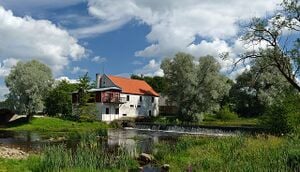
 Free lunches, brain breaks and happy teachers: why Estonia has the best schools in Europe, theguardian.com (Mar 27, 2024)
Free lunches, brain breaks and happy teachers: why Estonia has the best schools in Europe, theguardian.com (Mar 27, 2024)
Networks and sustainability initiatives[edit | edit source]
- Tallinn European Green Capital 2023, greentallinn.eu/en/, news page, greentallinn.eu
Environment quality[edit | edit source]
Community energy[edit | edit source]
As of 2023, Estonia has a wind power installed capacity of about 376 MW. All operational wind farms in the country are on land. Offshore wind farms are planned on Lake Peipus and in the Baltic Sea near the island of Hiiumaa.
Estonia operates a rare earth elements processing facility, one of the few outside China, and is developing Europe's first plant for producing rare earth permanent magnets, essential for electric vehicles and wind turbines. Production is expected to start in 2025.
Sustainable transport activism[edit | edit source]
Electric vehicles: Estonia is the first country in the EU and in the world to introduce a nation-wide, publicly serviced charging system for charging the batteries of electric vehicles. The 165 fast charging stations are equipped with connectors of the CHAdeMO standard. They are located throughout the entire country, including the islands, and have a maximum distance of 40–60 km in between. The charging stations can also be navigated via a smartphone app (currently only for Android). The relatively dense network and 30 minute quick charges are built to enable a country-wide electric vehicle network. The system offers a unitary booking service and several different tariffs, some of which appear attractively low priced. The charging station network puts Estonia at the forefront in Europe even though Norway actually has a higher penetration of electric vehicles. Estonia has a rate of 1 electric vehicle per 1000 capita, whereas Norway has 4 EVs per 1000 capita.[1]
News and comment[edit | edit source]
2023
 Unique Taskumets in Tallin's city center, greentallinn.eu/en (Aug 07, 2023) — Taskumets is a parking lot size garden inspired by the concept of rewilding
Unique Taskumets in Tallin's city center, greentallinn.eu/en (Aug 07, 2023) — Taskumets is a parking lot size garden inspired by the concept of rewilding Talking robots, urban bogs and free bikes: inside Europe’s ‘green capital’, Positive News (May 02, 2023)
Talking robots, urban bogs and free bikes: inside Europe’s ‘green capital’, Positive News (May 02, 2023)
2014
Estonia one of three European Union member countries that have already met their renewable energy goals for 2020, March 12[2]
One year of free public transport in Tallinn, February 19[3]
The Largest Free Mass Transit Experiment in the World, January 29[4]
2012
Tallinn to have free public transport from 2013,[5] March 26
2008
50,000 Estonians clean up their country in one day,[6] May 28
About Estonia[edit | edit source]
Estonia, officially the Republic of Estonia, is a country by the Baltic Sea in Northern Europe. It is bordered to the north by the Gulf of Finland across from Finland, to the west by the sea across from Sweden, to the south by Latvia, and to the east by Lake Peipus and Russia. The territory of Estonia consists of the mainland, the larger islands of Saaremaa and Hiiumaa, and over 2,300 other islands and islets on the east coast of the Baltic Sea, covering a total area of 45,335 square kilometres (17,504 sq mi). Tallinn, the capital city, and Tartu are the two largest urban areas. The Estonian language is the indigenous and official language. It is the first language of the majority of the population of 1.4 million.
The land of present-day Estonia has been inhabited by humans since at least 9,000 BCE. The medieval indigenous population of Estonia was one of the last pagan civilisations in Europe to adopt Christianity following the Papal-sanctioned Northern Crusades in the 13th century. After centuries of successive rule by the Teutonic Order, Denmark, Sweden, and the Russian Empire, a distinct Estonian national identity began to emerge in the mid-19th century. This culminated in the 1918 Estonian Declaration of Independence from the then-warring Russian and German empires. Democratic throughout most of the interwar period, Estonia declared neutrality at the outbreak of World War II, however the country was repeatedly contested, invaded, and occupied; first by the Soviet Union in 1940, then Nazi Germany in 1941, and ultimately reoccupied in 1944 by, and annexed into, the USSR as an administrative subunit (Estonian SSR). Throughout the 1944–91 Soviet occupation, Estonia's de jure state continuity was preserved by diplomatic representatives and the government-in-exile. Following the 1988–90 bloodless Estonian "Singing Revolution" against Soviet rule, the nation's full independence was restored on 20 August 1991.
References
